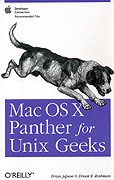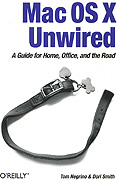eXtensions
|
Making OSX work better: Book reviews and Other Items
|
By Graham K. Rogers
Jepson, Brian and Ernest E. Rothman. Mac OS X Panther for Unix Geeks. O'Reilly. Sebastopol, CA: 2004. US$24.95. ISBN 0-596-00607-1
 Many users are happy chipping away at their Macs like they always did. But under the surface, the interface now hides Unix, and many are beginning to get the point. The authors of this work have opened the crack wider with this highly recommended book which is not for Unix novices (The Missing Manual will get you going).
Many users are happy chipping away at their Macs like they always did. But under the surface, the interface now hides Unix, and many are beginning to get the point. The authors of this work have opened the crack wider with this highly recommended book which is not for Unix novices (The Missing Manual will get you going).
Those familiar with Unix understand the inbuilt flexibility. This book shows just how to get the most out of the Unix-equipped Macs now current.
Although much of the book deals with work at the command line -- detailed configuring -- where necessary it examines Panther's direct links to Unix: for example, Directory Access.
The pages include one of the clearest explanations I have read for installing and using Fink -- building Unix software for OSX. Another strong section is on configuring an OSX machine as a server.
With risks from stability and viruses abounding on other platforms, some governments are seeking alternatives, particularly in mission-critical applications. This book goes a long way to showing that Apple has a sleeping giant under that pretty face.
Negrino, Tom and Dori Smith. Mac OSX Unwired: A Guide for Home, Office and the Road. O'Reilly. Sebastopol, CA: 2004. US$24.95. ISBN 0-596-00508-3
A recent phenomenon has been the move from wire-based systems towards wireless: the Negroponte Switch. This book looks at transferring data wirelessly, particularly Bluetooth and Broadband; but does include information on RF and infrared.
 Broadband is the common name for the 802.11x standard of wireless communication. Apple (and this book) concentrate on 802.11b and 802.11g. Bluetooth connectivity has also been built into the operating system, and Mac OSX Unwired has a large section on this.
Broadband is the common name for the 802.11x standard of wireless communication. Apple (and this book) concentrate on 802.11b and 802.11g. Bluetooth connectivity has also been built into the operating system, and Mac OSX Unwired has a large section on this.
Although Apple's "Airport" figures strongly here, and the authors explain clearly how to set up and configure these systems (Bluetooth too), they do not slavishly follow the Apple line. There is information on how to configure a network using Macs, based on non-proprietary hardware (and software): equipment that can be bought in Phantip Plaza, for example.
It is relatively easy to buy (or even make) the hardware and create your own system. In Thailand it may be prudent to check on the legality of providing service to the neighbours. One such system operates in the Siam Discovery Center. Although this is an Airport network, anyone can play as the standard is universal.
As is the case in many books published recently, security features highly in these pages. It is easy to find out what a person is typing if their machine is not properly secured. Mac OSX Unwired takes a serious look at this and other security problems.
With a little over 200 pages, Mac OSX Unwired is full of valuable content. Anyone thinking about wireless systems, would find much that is useful here.
Slot-loading Macs occasionally have problems when a CDROM fails to eject. One of my regular "Help" calls came last week: the disk had disappeared from the desktop but not come out into the light. I suggested a reboot, holding down the mouse button: problem solved.
We know that a paperclip, inserted into the hole on the right should eject a stubborn disk. The iMac has a guide inside the slot, just to the left of centre. If you use the curved end and push it carefully into the drive, then move it to the left, as the disk is trying to eject, that moves the guide aside.
I was transferring music from a collection of old CDs into iTunes recently. The first gave me a rare time: a couple of millimetres came out and then the disk went back in. With the others, I gave the edge a wipe using a soft cloth (I also cleaned the non-playing face). This improved ejection significantly.
Rumours about new Macs and software changes are starting. The most likely candidates for replacement are "anglepoise" iMacs. The Worldwide Developers Conference is from June 28 to July 2 at the Moscone Center West, San Francisco. Here the Apple faithfull gather, and Steve Jobs has his most partisan audience. Expansion of the G5 range is overdue. We were promised a 3GHz machine and it is late. With the new IBM chip technology announced on 31 March, some are even looking for a surprise G6.
Note: between writing this and its printing, a new 1.25GHz eMac was announced; and on 20 April 2004, information on three new 1.5GHz PowerBooks and a couple of 1.2GHz iBooks was released. For information (of course), try the Apple site.
Tiger is the name for OSX 10.4; or perhaps 10.5. An update to follow 10.3 is not surprising -- no company can stagnate. Tiger is a recent change from the internal working name of "Merlot". What is being debated, is whether it will be a step up the ladder, available this year, or a radical overhaul -- a competely new operating system -- in a year's time. The latter would also give our credit cards a rest.

For further information, e-mail
to Graham K. Rogers.
Back to
eXtensions
To
eXtensions: Book Reviews
To
eXtensions: Year One
Back to homepage
 Many users are happy chipping away at their Macs like they always did. But under the surface, the interface now hides Unix, and many are beginning to get the point. The authors of this work have opened the crack wider with this highly recommended book which is not for Unix novices (The Missing Manual will get you going).
Many users are happy chipping away at their Macs like they always did. But under the surface, the interface now hides Unix, and many are beginning to get the point. The authors of this work have opened the crack wider with this highly recommended book which is not for Unix novices (The Missing Manual will get you going).
 Broadband is the common name for the 802.11x standard of wireless communication. Apple (and this book) concentrate on 802.11b and 802.11g. Bluetooth connectivity has also been built into the operating system, and Mac OSX Unwired has a large section on this.
Broadband is the common name for the 802.11x standard of wireless communication. Apple (and this book) concentrate on 802.11b and 802.11g. Bluetooth connectivity has also been built into the operating system, and Mac OSX Unwired has a large section on this.
